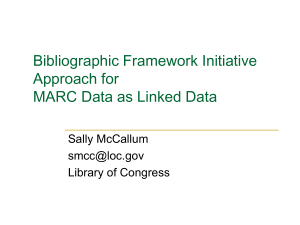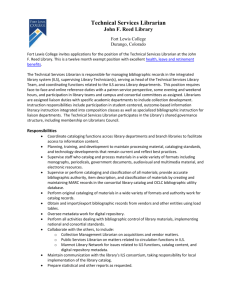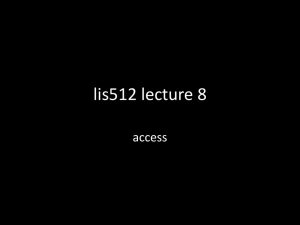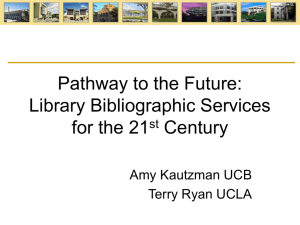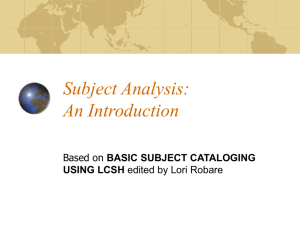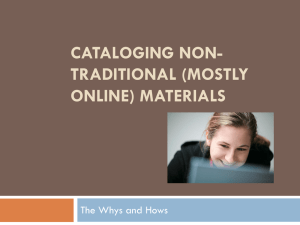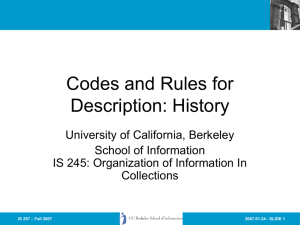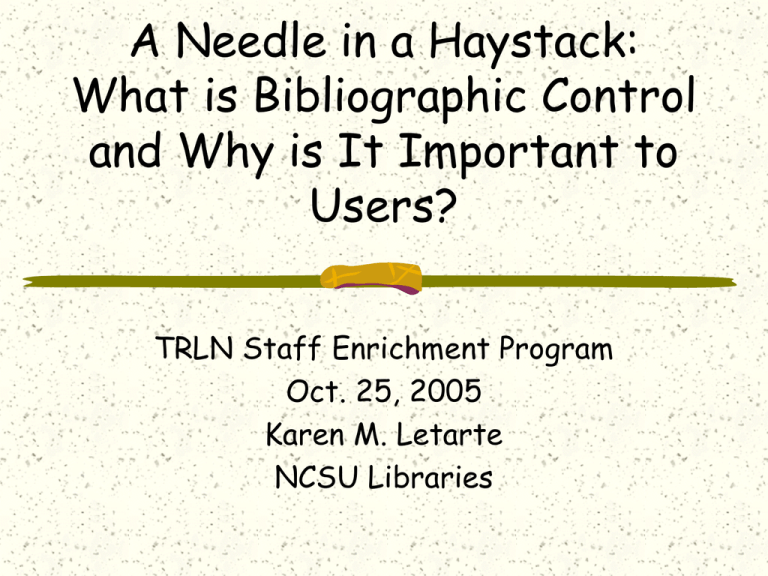
A Needle in a Haystack:
What is Bibliographic Control
and Why is It Important to
Users?
TRLN Staff Enrichment Program
Oct. 25, 2005
Karen M. Letarte
NCSU Libraries
What IS Bibliographic Control?
Operations by which recorded
information is organized or arranged
according to established standards
and thereby made readily identifiable
and retrievable.
Organization of and access to
information
--Lois Mai Chan, 1994
Parallel Concept
Authority control is a parallel concept
to bibliographic control (and will be
discussed later)
Linked Concept
Universal Bibliographic control– which
is the dream of the international
cataloging community.
Under UBC, every published item
would be cataloged once(as close to
publication as possible) and the
record for that item would then be
available to be shared by anyone.
How is Bibliographic Control
Achieved?
Through the use of bibliographic
tools
In which each item of knowledge is
represented by a bibliographic record
or entry
Go, Team!!
Many people within and outside of
libraries help to create our existing
system of bibliographic control
Players Outside the Library
Publishers
Vendors
National libraries (e.g., The Library of
Congress)
Bibliographic utilities (e.g., OCLC, RLIN)
Indexing and Abstracting industry (that
produce bibliographic databases and
indexes)
Within the Library
Collection managers/bibliographers
Acquisitions librarians and staff
Systems and Information Technology
Staff (who provide support for finding
tools such as the Catalog, Database Finders
and Metasearch tools)
Cataloging librarians and staff
Reference Librarians
Access and Delivery Services
Global view from concept to bib
record
Author
Publisher
Vendor
Selection and Marketing Tools
Selector/Bibliographer
Acquisitions Dept. orders
and receives book
Cataloging Department
Creates Final Bib Record
Creates Order Record,
often with with
Bib record attached
The Catalog
Some types of information are
traditionally accessed through the
catalog, e.g., books, entire serial
titles.
Other Types Of Resources Are
Controlled Outside the Catalog
Via Indexing and Abstracting tools
(such as indexes and databases):
Journal Articles
Newspaper articles
Increasingly, separate metadata and
access mechanisms that are
discipline-specific (e.g., EAD, FGDC)
Why Do We Need Catalogs?
Doesn’t everyone use the
Internet Anyway?
Focus on Books for Now
There are many types of information
libraries acquire for the benefit of
users: books, journals, electronic
resources, etc.
What is a Bibliographic Record?
A bib record is one entry in an online
or card catalog.
Key concept: Surrogacy
Bib Control Standards
To make retrieval possible, it is
necessary to record specific
bibliographic data in a standard way
This data is combined—using precise
rules—to form the bibliographic
record or entry).
Bibliographic Records Contain 2
Basic Types of Information
1. Descriptive information that identifies the
item
2. Access points: labels (or points of entry)
by which the item is retrievable
3. *Now that most parts of the catalog
record are searchable almost all data is a
potential access point for someone*
Standards Used to Create
Bibliographic Records for Books
Anglo-American cataloging rules
MARC Formats for Bibliographic,
Holdings and Authority Data
Library of Congress Rule
Interpretations
ISBD (International Standard
Bibiliographic Description)
What is ISBD?
Stands for International Standard
Bibliographic Description, developed
in the 1970’s.
Allows for the elements of the
cataloging record to be recorded in a
standard order and with standardized
punctuation so as to be recognizable
regardless of language.
What IS MARC?
Stands for MAchine Readable Cataloging.
A communication format.
Breaks the catalog record into pieces that
an online system can identify and
understand, via a leader, directory,
numeric tags, and indicators.
See: OCLC Bib Formats and Standards for
further information
Very Basic MARC Fields
020: ISBN
040: Source of record (who created it) [DLC=Lib. of
Congresss]
050 or 090: LC Call No. (controlled field)
1XX: Author (heading=controlled field)
245: Title and statement of responsibility
Transcribed
250: Edition statement
fields
260: Publication information
300: Physical description
4XX/8XX: Series information (both controlled and
transcription)
5XX: Notes (may or may not be transcribed)
6XX: Subject headings (Controlled headings)
7XX: Other access points (people or titles related to the
item being cataloged) (Controlled headings)
Evolving Standards
Current code is AACR2, rev.
It IS a content standard, with precise
rules governing each area of the bib record
(i.e., dictates what goes into the MARC
container)
AACR3 is coming!!
Will be completely restructured
Heavily influenced by the Functional
Requirements for Bibliographic Records
(FRBR) model
New Rules Will Focus on Users
Users Tasks as Defined by FRBR
1. Find
2. Identify
3. Select
4. Obtain
Reminiscent of Cutter’s
Objectives for a Dictionary
Catalog (1901)
1. To enable a person to find a book of which
either
A. the author)
B. the title)
C. the subject)
is known
2. To show what the library has
D. by a given author
E. on a given subject
F. in a given kind of literature
3. To assist in the choice of a book
G. as to its edition (bibliographically)
H. as to its character (literary or topical)
Processes of Cataloging
3 main processes:
Descriptive cataloging
Subject cataloging and classification
Authority control
Post-Cataloging functions: marking,
binding, record maintenance
Some Basic Principles Upon
Which Current AACR Rules Are
Based
Chief Source of Information
Transcription
Increasing Primacy of Content over
Carrier (or type of material)
Exercise: What Do We Need to
Know About A Book to Find it?
Where Do Bib Records Come
From?
From shared cataloging databases
such as OCLC
From publishers via LC’s CIP program
From vendors
Through original input into local and
national catalogs
CIP Program
Cataloging-In-Publication
http://cip.loc.gov/
“A Cataloging in Publication record (aka CIP
data) is a bibliographic record prepared by
the Library of Congress for a book that has
not yet been published. When the book is
published, the publisher includes the CIP data
on the copyright page thereby facilitating
book processing for libraries and book
dealers.”
— THE—
INTERPRETER
ALICE KAPLAN
FREE PRESS
NEW YORK LONDON TORONTO SYDNEY
T.P.
fP
Verso of TP.
FREE PRESS
A Division of Simon & Schuster, Inc.
1230 Avenue of the Americas
New York, NY 10020
Copyright © 2005 by Alice Kaplan
All rights reserved,
Including the right of reproduction in whole or in part in any form.
FREE PRESS and colophon are trademarks of Simon and Schuster
Manufactured in the United States of America
Library of Congress Cataloging-In-Publication Data
Kaplan, Alice Yaeger.
The interpreter / Alice Kaplan.
p. cm.
Includes bibliographical references and index.
1. Hendricks, James E., 1923-1944—Trials, litigation, etc.
2. Whittington, George P., 1913-1996—Trials, litigation, etc.
3. African American soldiers—France—Social Conditions. 4.
African American soldiers--History—20th Century.5. World
War, 1939-1945—African Americans. 6. United States.
Army—Officers. 7. Courts-martial and courts of inquiry—
France. 8. Trials (Murder)—France. 9. Guilloux, Louis, 18991980. I. Title.
D810.N4K37 2005
940.54’0089’96073—dc22
Fixed
Fields
LC Call No.
Various
Control
Numbers
Author (controlled heading)
Title
Publication Info
Phys. Descr.
Descriptive
and Subject
Info
Subject
Headings
(Controlled)
Person as subject (controlled heading)
What is Authority Control?
Concept of Uniform and Unique
Heading
All works by a given author, and
ONLY that author, are always listed
under the same heading.
The same is true for subject
headings.
Authority Files
An “established” heading is created for
each author or subject heading and this
authorized form is recorded in an
authority record.
Authority records also contain cross
references to direct users from an
unauthorized form of a name or subject to
an authorized form.
Authority records are stored in a separate
part of the catalog called the authority
file.
Authority Example
The heading for Dan Brown, author of
The Da Vinci Code, has been
established as: Brown, Dan, 1964All works by Dan Brown, and ONLY
Dan Brown, will always contain this
form of name in a heading (i.e., access
point).
LC Control
Number:
HEADING
n 95086067
Brown, Dan, 1964-
000
00746cz 2200181n 450
001
2690971
005
20020209072826.0
008
950830n| acannaabn |a aaa
010
__ |a n 95086067
035
__ |a (OCoLC)oca03909218
040
__ |a DLC |b eng |c DLC |d DLC |d OCoLC
053 _0 |a PS3552.R685434
100 1_ |a Brown, Dan, |d 1964400 1_ |a Brown, Danielle, |d 1964670 __ |a 187 men to avoid, 1995: |b t.p. (Danielle
Brown) colophon (lives in New England)
670 __ |a Digital fortress, 1998: |b CIP t.p. (Dan Brown)
pub. blurb (lives in Exeter, N.H.; teaches English at
Phillips Exeter Academy)
670 __ |a Email from author, Apr. 9, 1998 |b (b.
6/22/64; preferred name is Dan Brown; used
pseudonym Danielle Brown for 187 men to
avoid)
Library of Congress
MARC Authority
Record for Dan
Brown.
100 field shows form of
name that must be used
whenever name appears as
a heading, regardless of
how name appears on item
053 shows LC established
call no. for this author
400 shows the see
reference from a variant
form of name
670s show evidence from
sources justifying heading
and reference decisions
How does a See Reference
Work?
If a user happens to be looking for the
book 187 men to avoid and does a search
for Danielle Brown, the following reference
should be shown, leading the user to the
correct heading:
Brown, Danielle, 1964SEARCH UNDER
Brown, Dan, 1964-
Principles of LC Subject
Headings
A controlled vocabulary
Syndetic Structure
Use the most specific s.h. that describes the
entire work
Improves precision of retrieval
What Happens After Cataloging
Shelf preparation (property stamping,
marking, security stripping, binding)
Reference librarians and staff assist
users in locating information
Access and Delivery Services
librarians and staff check out
materials for users and search for
missing materials
Meta-What-A??
Metadata=structured data about data.
(e.g., a manuscript collection is data, the
EAD finding aid that describes the
collection is metadata.)
There are many types of metadata:
descriptive, structural, administrative, etc.
Library cataloging is just one flavor of
metadata– and librarians have been
doing it for over 100 years
Metadata Standards
Many were created to meet the needs of a
particular community of users (e.g., FGDC for the
Geographic Data Community)
In many instances, AACR/MARC cataloging did not
meet the community’s needs or the expertise to
create MARC records was not there
Most metadata standards are in their infancy
AACR/MARC robust and mature
LC has developed an XML DTD for MARC called
MARCXML, that makes MARC data more readily
interoperable with other standards and removes
some of the inherent redundancies in MARC.
The Dublin Core Element Set,
v.1.1 (15 elements)
Title
Creator
Subject
Description
Publisher
Contributor
Date
Type
Format
Identifier
Source
Language
Relation
Coverage
Rights
From the Dublin Core Metadata Element Set,
Version 1.1: Reference Description
The Elements
Element Name: Title
Label:
Title
Definition:
A name given to the resource.
Comment:
Typically, Title will be a name by which the
resource is formally known.
Element Name: Creator
Label:
Creator
Definition:
An entity primarily responsible for making the
content of the resource.
Comment:
Examples of Creator include a person, an
organization, or a service. Typically, the name of
a Creator should be used to indicate the entity.
Create a Skeleton Record for
The Painted Drum
THE PAINTED DRUM
T.P.
LOUISE ERDRICH
HarperCollinsPublishers
T.P. verso
THE PAINTED DRUM. Copyright © 2005 by Louise Erdrich. All rights reserved.
Printed in the United States of America. No part of this book may be used or
reproduced in any manner whatsoever without written permission except in the
case of brief quotations embodied in critical articles and reviews. For information,
address HarperCollins Publishers, 10 East 53rd St. New York, NY 10022.
FIRST EDITION
Book has 277 pages, no illustrations, with a spine
height of 24 cm.
Library of Congress Cataloging-In-Publication Data
Erdrich, Louise.
The painted drum : a novel / Louise Erdrich. – 1st ed.
p. cm.
ISBN-10:0-06-051510-4
ISBN-13: 978-0-06-051510-2
1. Indians of North America—Fiction. 2. Indian
reservations. 3. New
England—Fiction. 4. Villages—
Fiction. I. Title.
PS3555.R42P35 2005
813’.54—dc22
Very Basic MARC Fields
020: ISBN
040: Source of record (who created it) [DLC=Lib. of
Congresss]
050 or 090: LC Call No. (controlled field)
1XX: Author (heading=controlled field)
245: Title and statement of responsibility
Transcribed
250: Edition statement
fields
260: Publication information
300: Physical description
4XX/8XX: Series information (both controlled and
transcription)
5XX: Notes (may or may not be transcribed)
6XX: Subject headings (Controlled headings)
7XX: Other access points (people or titles related to the
item being cataloged) (Controlled headings)
So What’s the Point?
“The better the catalog record, the quicker readers
can find the book in the catalog and determine
whether it meets their needs. Your … catalog card
or online record must:
(1) uniquely describe the book being cataloged; and
(2) provide sufficient access points, including
author(s), title(s), and appropriate subjects.”
----McCroskey and Turvey, KQ32:5 2004, 36.

